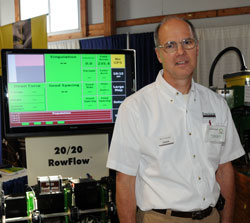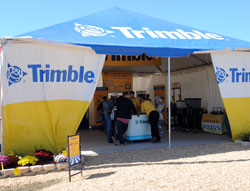 If you’re familiar with yield mapping, automatic boom section control or other tasks that require a GPS signal, you may not truly understand how it works…or you may not care as long as it works, right!
If you’re familiar with yield mapping, automatic boom section control or other tasks that require a GPS signal, you may not truly understand how it works…or you may not care as long as it works, right!
 Let me simplify things. Basically, 11,000 miles from earth is a constellation of satellites (between 24 and 32 at any given time) strategically placed and managed by the Air Force. You know this constellation of satellites as GPS. The receiver on your vehicle receives signals from three or more satellites to determine vehicle location. This concept is called “trilateration”; four or more satellites are needed for accurate time and location.
Let me simplify things. Basically, 11,000 miles from earth is a constellation of satellites (between 24 and 32 at any given time) strategically placed and managed by the Air Force. You know this constellation of satellites as GPS. The receiver on your vehicle receives signals from three or more satellites to determine vehicle location. This concept is called “trilateration”; four or more satellites are needed for accurate time and location.
Since GPS satellite signal has to travel through the ionosphere (charged particles in the atmosphere) and space weather (commonly referred to as sun spots), some time error or delay occurs. To correct this and improve accuracy (called differential correction, or DGPS), two receivers are needed to receive the signals. A stationary receiver calculates all signals, measures the timing errors, and then provides a corrected signal to the receiver in your vehicle.
Differential GPS Signals:
WAAS – Wide Area Augmentation System (WAAS) is an air navigation aid developed by the FAA to add accuracy to GPS by using a network of ground-based reference stations. It is a free signal, and it provides position accuracy within 25 feet or better (sometimes within 7 feet), at least 95% of the time.
OmniSTAR HP service offers a 2-4 inch pass-to-pass accuracy and 4-inch long-term repeatability. It is particularly useful for agricultural machine guidance and many surveying tasks. It operates in real time, and without the need for local base stations or telemetry links. OmniSTAR HP is a true advance in the use of GPS for on-the-go precise positioning.
OmniSTAR XP service offers a 3-5 inch pass-to-pass accuracy and 8-inch long-term repeatability. It is especially suited for agricultural automatic steering systems. While it is slightly less accurate than HP, it is available worldwide and its accuracy is a significant improvement over regional differential systems such as WAAS.
OmniSTAR VBS (not used much in the U.S.) is a sub-meter (less than 39 inches) level of service. A typical 24-hour sample of VBS will be significantly less than 1 meter horizontal position error (95% of the time), with a horizontal error close to 1 meter 99% of the time.
RTK – Real Time Kinematic (RTK) GPS is the gold standard in signal accuracy, placing your vehicle within 1 inch of its target. And RTK system delivers such accuracy by counting the number of wavelengths of the carrier frequency radio signals between a minimum of five satellites and receiver. These systems typically cost more because they require a base station, or tapping into a neighbor or a nearby retailer’s RTK network.
How do you judge what type of signal will best fit your operation.
Pass-to-Pass Accuracy. This measures the relative accuracy of a GPS receiver over a 15 minute interval. This is typically thought of as “guess row error” when driving rows, or skip/overlap from one pass to the next when driving swaths. GPS receivers can provide pass-to-pass accuracy that is acceptable for operations such as tillage, spreading, spraying and harvesting. Typically a DGPS receiver will provide 6–12 inch pass-to-pass accuracy performance over a 15-minute interval.
Year-to-Year Accuracy. GPS receivers using dual frequency technology can be as accurate as +/- 1 inch and can be applied to operations requiring extremely precise fieldwork such as the laying of drip tape directly in preformed beds, or strip-till applications of fertilizer followed by planting of seed directly over such strips of fertilizer. Only GPS receivers using RTK technology can deliver +/- 1-inch year-to-year accuracy. You may have also heard this referred to as “repeatability”, returning to the same location after a time period has passed.
Hope this gives you a brief glimpse behind some of the technology. And don’t forget to check out Ag Leader’s website early next week for a new look, and possibly some other news…

 USDA crop analysts add another tool to their crop monitoring capability by approving
USDA crop analysts add another tool to their crop monitoring capability by approving 
 Farmers Edge Precision Consulting based in Winnipeg, Manitoba has become a fast-growing business helping farmers cut fertilizer costs and increase profits. The two agronomy experts who started the company just received an entrepreneur award, according to a
Farmers Edge Precision Consulting based in Winnipeg, Manitoba has become a fast-growing business helping farmers cut fertilizer costs and increase profits. The two agronomy experts who started the company just received an entrepreneur award, according to a 
 Besides taking part in the field demonstrations at Sunbelt Ag Expo I also wandered through the indoor exhibits. The first one I stopped at was
Besides taking part in the field demonstrations at Sunbelt Ag Expo I also wandered through the indoor exhibits. The first one I stopped at was  The 2009 Sunbelt Ag Expo has concluded and it did include a number of exhibits from precision product companies. One of those, having the largest field demonstration wasTrimble. I stopped and spoke with Matt Hesse, Autopilot Sales Manager.
The 2009 Sunbelt Ag Expo has concluded and it did include a number of exhibits from precision product companies. One of those, having the largest field demonstration wasTrimble. I stopped and spoke with Matt Hesse, Autopilot Sales Manager. Always good to see high technology magazines talk about precision agriculture that’s happening down on the farm. My favorite hi-tech pub, Wired, just posted a nice story on their website:
Always good to see high technology magazines talk about precision agriculture that’s happening down on the farm. My favorite hi-tech pub, Wired, just posted a nice story on their website:  John Deere has now updated its popular autonomous
John Deere has now updated its popular autonomous